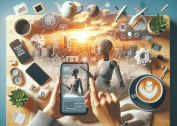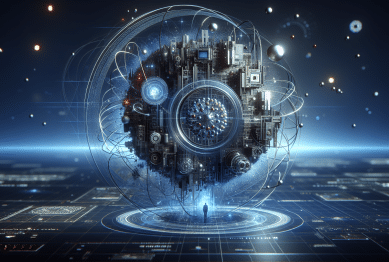Many daily tech tasks already rely on artificial intelligence, even if it’s barely visible. Discover how AI tools shape work, entertainment, and information – and why understanding them matters for future readiness in a digital world.
AI Assistants Hidden in Everyday Apps
Whether typing an email or searching the web, AI assistants streamline tasks quietly. Email apps flag grammar issues with AI, while browsers suggest relevant search queries. These functions seem normal, but advanced natural language processing makes them possible. Many notice the results—clearer communication or faster research—but few recognize the sophisticated algorithms at work in the background. The invisible integration of artificial intelligence means ordinary routines grow more efficient without the need for tech expertise. Acting as silent helpers, these systems improve accuracy and user experience while continuously learning.
Personal digital assistants such as Siri and Google Assistant turn spoken questions into useful answers. They set reminders, transcribe text, and fetch calendar appointments, making smart devices almost indispensable for organizing lives. Behind these smooth exchanges, machine learning powers voice recognition and context understanding—abilities refined through analyzing huge samples of speech and behavior. This makes personal productivity more attainable for those navigating work, home, or travel. Over time, these AI-driven platforms evolve, adapting to the habits of individual users and refining recommendations in subtle ways.
Recommendation engines in popular streaming services also employ AI to suggest music, shows, and articles. These tools draw from your choices and those of millions to predict what could interest you next. For example, selecting a documentary on climate change prompts further eco-focused suggestions. Such systems contribute to how information is found and retained, influencing not just preferences but perspectives. The more one interacts with AI-powered systems, the more personalized content becomes—quietly transforming everyday decision-making.
Smart Home Gadgets Relying on Automation
Smart thermostats, doorbell cameras, and lighting systems rely on AI to adapt to routines, anticipate needs, and boost energy savings. They sense occupancy patterns or temperature preferences, then make real-time adjustments. Homeowners often see comfort and efficiency rise, but the underlying neural networks and data analytics remain nearly invisible. The convenience of controlling devices from a smartphone is powered by advanced algorithms that process enormous data streams. As a result, household management becomes more seamless and secure with less manual intervention required.
Security is another area transformed by artificial intelligence. Cameras analyze footage to detect unfamiliar faces, filter out harmless movement, and alert users to possible intrusions. Machine learning sifts through countless visual cues to distinguish family members from strangers. Alerts sent to phones represent just the tip of complex analytical processes drawn from AI research. The sophistication lies in continuous self-improvement, where each event sharpens the system’s ability to prevent false alarms and identify real threats more accurately over time.
Voice-activated smart speakers deepen the integration of AI in daily life. Commands to play music, track packages, or adjust lighting pass through networks of machine learning models that interpret phrasing, filter background sounds, and select relevant actions. The experience is nearly magical in its simplicity, but underneath is a sophisticated choreography of speech recognition, pattern analysis, and contextual logic. These advancements offer not only ease but new ways to interact with home environments, lowering barriers to technology for all ages and abilities.
Healthcare Insights Driven by Machine Learning
Artificial intelligence is increasingly present in healthcare, often without being overtly visible. Appointment scheduling bots, symptom checkers, and telemedicine platforms use AI to triage cases and recommend follow-up care steps. For example, chat-based tools interpret descriptions of symptoms, drawing on medical literature and databases to advise on next steps. While they cannot replace doctors, these systems reduce barriers to care, helping many seek timely attention or escalate urgent cases. The algorithms behind these tools are constantly refined as they learn from large pools of anonymized patient interactions.
Wearable health trackers monitor heart rates, sleep patterns, and activity levels, using machine learning to spot trends and provide personalized advice. AI tools can detect irregularities in heartbeats or flag patterns that might indicate potential health risks. Though users only see friendly graphs and reminders, deep data analytics power these preventive measures in the background. Such trackers also motivate healthier behaviors, encouraging small adjustments that, over time, may boost wellness. Researchers frequently update these systems, aiming for higher accuracy and more actionable insights for all users.
Diagnostic imaging is another field where AI’s impact is growing. Computer algorithms examine X-rays, MRIs, or CT scans, flagging anomalies that radiologists might want to review. Studies show certain AI models rival humans in detecting early signs of diseases, particularly when screening large populations. For patients, this translates to more reliable screening and earlier intervention. Hospitals adopt these technologies to reduce errors and free up time for clinicians to focus on complex cases, enhancing both efficiency and patient care quality. Machine learning continues to expand its role, helping medical professionals process increasing volumes of information.
AI in Search Engines and Information Filters
Conducting a web search often feels simple, but immense AI systems shape every result. Search engines rely on machine learning to interpret queries, rank sources, and weed out misleading information. Each search benefits from billions of previous interactions, as AI learns language nuances, trending topics, and user intent. This ensures faster, more accurate answers in real time, surfacing credible resources while filtering out digital noise. For users, this means reliable navigation of a rapidly expanding information ecosystem.
Spam detection harnesses artificial intelligence to filter out malicious or irrelevant content. Whether in email inboxes or social media feeds, AI models scan text for suspicious links, patterns, or behaviors that resemble phishing attempts. This screening process protects data and keeps users focused on what matters most. The complexity and scale of today’s communication platforms would be impossible to manage manually, making these automated detection systems indispensable for digital well-being and cybersecurity.
Personalized news feeds and content recommendations also depend on AI-driven content curation. News aggregators and social platforms track preferences and engagement, adapting choices in real time. These AI-driven suggestions can gently broaden perspectives or reinforce existing interests, depending on settings and patterns. While the mechanics are hidden, the experience shapes public understanding and individual knowledge—making it worthwhile to recognize the subtle presence and influence of these algorithms on daily life.
AI in Finance and Secure Transactions
AI tools shape how people make payments, invest, and monitor transactions. Banks deploy fraud detection algorithms that analyze transaction patterns around the clock, silently flagging activity that differs from the established norm. Most customers never see the decision-making, only quick alerts about possible suspicious transactions or seamless acceptance of a legitimate purchase. These AI models process massive data sets, learning continuously to react faster and minimize financial losses.
Robo-advisors, powered by artificial intelligence, guide users through investment decisions based on risk preferences and long-term goals. They recommend diversified portfolios, rebalance automatically, and offer regular progress updates—all often through intuitive mobile applications. This democratizes access to financial planning, allowing more people to manage investments with minimal financial knowledge or effort. Behind the convenience lies rigorous analytics, regulatory safeguards, and data-driven risk assessments maintained by machine learning protocols.
Even simple actions like checking a bank balance or budgeting rely on predictive analytics. AI learns from previous spending, highlighting trends or projecting expenses for months ahead. These insights empower smarter money management and flag overspending risks before problems arise. The rise of digital wallets, virtual cards, and contactless payments all carry embedded AI features—each further cementing artificial intelligence as a daily fixture in modern finance.
Staying Conscious of AI and Digital Literacy
Despite the many benefits AI brings, it’s important for users to understand where and how artificial intelligence operates in their digital routines. Transparency matters. Knowing what kind of data is shared, how it’s analyzed, and which systems are driven by algorithms enables more conscious choices online. Users increasingly value privacy and data security, prompting companies to clarify when and where AI is applied. Digital literacy includes not just technical skills, but awareness of how invisible digital forces shape daily experience.
Ongoing education in AI literacy helps everyone navigate an evolving landscape of intelligent tools. Workshops, online courses, or self-guided research can reveal more about artificial intelligence, from the basics of neural networks to ethical questions around data use. Curiosity about these systems can lead to greater empowerment rather than passive reliance. By demystifying advanced technologies, individuals can engage more critically with platforms they use and identify practical opportunities for personal growth or productivity improvement.
Understanding AI’s influence does not require technical mastery. It means asking questions—‘How does this tool work?’ or ‘What information does it use to make recommendations?’—and seeking answers in trustworthy, accessible sources. Greater awareness supports informed digital citizenship and better collaboration with the technology that will continue to evolve and shape societies. Making invisible AI visible is a crucial step towards responsible and secure participation in an AI-driven world.
References
1. U.S. Department of Energy. (n.d.). Artificial Intelligence (AI). Retrieved from https://www.energy.gov/science-innovation/artificial-intelligence
2. Mayo Clinic. (n.d.). Artificial intelligence in health care. Retrieved from https://www.mayoclinic.org/tests-procedures/artificial-intelligence/overview/ovc-20477077
3. Stanford University. (n.d.). AI Index Report. Retrieved from https://aiindex.stanford.edu
4. Federal Trade Commission. (n.d.). Artificial Intelligence. Retrieved from https://consumer.ftc.gov/articles/artificial-intelligence
5. Pew Research Center. (n.d.). Public Attitudes Toward Artificial Intelligence. Retrieved from https://www.pewresearch.org/internet/2021/06/16/public-attitudes-toward-artificial-intelligence/
6. MIT Technology Review. (n.d.). How AI is changing the future of work. Retrieved from https://www.technologyreview.com/2021/12/07/1040677/how-ai-is-changing-the-future-of-work/









